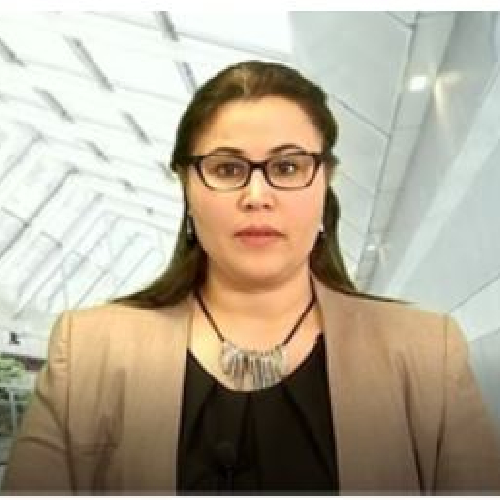
- Le Pôle
- Programmes
- Entreprises
- Research Center
- International
- Vie étudiante
- Presse
- Agenda


Docteur en systèmes mécaniques et matériaux de l'université de Technologie de Troyes et Ingénieure de l'Ecole Nationale d'Igenieurs de Sfax - Tunisie. Mes thématiques de recherche en mécanique numérique et analyses expérimentales concernent essentiellement la modélisation micro-mécanique du comportement des solides, les couplages multiphysiques et l'étude de la rupture et la tenue en fatigue.
FATMA HENTATI; RIDHA MNIF; Naila Hfaiedh; Johann Petit
Experimental study on the temperature effect and constitutive modeling of the tensile response of PC/ABS blend Article de journal
Dans: Polymer Bulletin, 2025.
@article{hentati_3277,
title = {Experimental study on the temperature effect and constitutive modeling of the tensile response of PC/ABS blend},
author = {FATMA HENTATI and RIDHA MNIF and Naila Hfaiedh and Johann Petit},
url = {http://dx.doi.org/10.1007/s00289-024-05631-0},
year = {2025},
date = {2025-01-01},
journal = {Polymer Bulletin},
abstract = {This study investigates the tensile properties of the PC/ABS blend under both small
and large strains using experimental analysis and predictive analytical models. The
influence of temperature and strain rate on the tensile response were evaluated, with
strain rates reaching from 1.25 × 10?
4 to 1.25 × 10?
1 s?
1 and temperatures ranging
from 20 to 150 °C. The experimental results indicate that the tensile behavior of
the material blend exhibits sensitivity to both strain rate and temperature. As the
temperature rises, the yield strength and strain at failure decrease significantly;
while, the young's modulus only slightly decreases. Among several constitutive
models studied, including the G'sell and Jonas and Duan-Saigal-Greif-Zimmerman
(DSGZ) models, a modified version of the DSGZ model, referred to as the
?Zhu et al.? model. However, this model struggled to accurately represent material
behavior at elevated temperatures. To address this limitation, a new model named
Hentati-Mnif-Hfaiedh-Petit (HMHP) was developed by introducing a temperature
dependence into two key parameters of the ?Zhu et al.? model. This improvement
enabled the HMHP model to more accurately predict tensile behavior across a wide
temperature range. The results confirm that the new developed model, HMHP provides
a reliable prediction of tensile properties at different temperatures.},
keywords = {},
pubstate = {online},
tppubtype = {article}
}
HAJER KETATA; Naila Hfaiedh; Michèle Kanhonou; Houssem Badreddine
Impact of fractured tibia implant fixation devices on bone stiffness during bending test Article de journal
Dans: Medical Engineering & Physics, vol. 131, p. 104228, 2024.
@article{ketata_3136,
title = {Impact of fractured tibia implant fixation devices on bone stiffness during bending test},
author = {HAJER KETATA and Naila Hfaiedh and Michèle Kanhonou and Houssem Badreddine},
url = {https://www.sciencedirect.com/science/article/pii/S1350453324001292?via%3Dihub},
year = {2024},
date = {2024-08-01},
journal = {Medical Engineering & Physics},
volume = {131},
pages = {104228},
abstract = {This study focuses on evaluating the failure resistance of a previously reduced tibia with internal fixation implants as PLate (PL) or InterMedullary Nail (IMN), subjected later to a tibial lateral trauma. To replicate this type of trauma, which can be caused by a road accident, a three-point bending test is considered using experimental tests and numerical simulations.
The withstand evaluation of the tibia-PL and tibia-IMN structures was conducted by following the load transfer through, the bone and the used implants. The analysis, up to tibia failure, required the use of an elasto-plastic behaviour law coupled to damage. The model parameters were identified using experimental tests.
Il was shown that the tibia-IMN structure provided a bending resistant load up to three-times higher than the tibia-PL. In fact, the used screws for plate fixation induced a high level of stress in the vicinity of threaded region, leading to a crack initiation and a damage propagation. However, in tibia-IMN structure the highest stress was generated in the trapped zone between the loader and the nail, promoting crack formation.
From a biomechanical point of view, the structure with IMN is safer than the structure with PL, whose fixation induces earlier damage in bone.},
keywords = {},
pubstate = {published},
tppubtype = {article}
}
Aymen Khadimallah; Johann Petit; Naila Hfaiedh; Amna Znaidi
Characterization of fatigue behavior of AA2024-T351 aluminum alloy Article de journal
Dans: Fatigue & Fracture Of Engineering Materials & Structures, vol. 46, no. 10, p. 3543-4072, 2023.
@article{khadimallah_2380,
title = {Characterization of fatigue behavior of AA2024-T351 aluminum alloy},
author = {Aymen Khadimallah and Johann Petit and Naila Hfaiedh and Amna Znaidi},
url = {https://onlinelibrary.wiley.com/share/author/5HS4PJKGQVKNQNGDT9QT?target=10.1111/ffe.14102},
year = {2023},
date = {2023-10-01},
journal = {Fatigue & Fracture Of Engineering Materials & Structures},
volume = {46},
number = {10},
pages = {3543-4072},
abstract = {The paper aims to investigate the fatigue behavior of the widely used
AA2024-T351 aluminum alloy in the aircraft industry. An experimental program
was conducted to study the fatigue life and damage behavior under symmetrical
tensile-compressive loading. Cyclic tests in the low cycle fatigue
regime were performed under fully reversed total strain amplitudes from 0.6%
to 1.2%. The AA2024-T351 alloy exhibited cyclic hardening until failure. Symmetric
high cycle fatigue tests were also performed and the parameters for
fatigue life estimation using the Manson-Coffin-Basquin model were identified.
Elasto-plastic behavior was analyzed through stress-strain hysteresis
loops, evaluating kinematic and isotropic hardenings. Kinematic hardening
was found to be strain amplitude dependent, unlike the isotropic hardening.
The evolution of the isotropic variable with the percentage of fatigue life could
be described by an exponential law. Fractography investigations showed crack
initiation at the specimen border with quasi-cleavage and then crack propagating
by striation before ductile fracture.},
keywords = {},
pubstate = {published},
tppubtype = {article}
}
Kai Zhang; Houssem Badreddine; Naila Hfaiedh; Khemais Saanouni; Jianlin Liu
Failure prediction of magnesium alloys based on improved CDM model Article de journal
Dans: International Journal Of Solids And Structures, vol. 217-218, p. 155-177, 2021.
@article{zhang_1406,
title = {Failure prediction of magnesium alloys based on improved CDM model},
author = {Kai Zhang and Houssem Badreddine and Naila Hfaiedh and Khemais Saanouni and Jianlin Liu},
url = {https://www.sciencedirect.com/science/article/abs/pii/S0020768321000214?via%3Dihub},
year = {2021},
date = {2021-01-01},
journal = {International Journal Of Solids And Structures},
volume = {217-218},
pages = {155-177},
abstract = {The aim of this contribution is to improve the behavior and failure prediction accuracy for magnesium alloy sheet forming simulation by using advanced fully coupled Continuum Damage Mechanics (CDM) model. Starting from known fully coupled constitutive equations at large inelastic (plastic or viscoplastic) strains, three aspects are enhanced on the CDM model developed by Saanouni (2012). The first one concerns the accurate description of tension-compression asymmetry in yielding and hardening of magnesium alloys induced by combined slip and twinning deformations. The second concerns introducing the stress state dependence in damage evolution to improve the fracture prediction under various loading paths. The third deals with temperature and strain rate (viscosity) effects for metal forming processes at elevated temperatures. The improved fully coupled constitutive equations were implemented into finite element code ABAQUS/Explicit via user subroutine VUMAT including the specific local integration scheme to compute the state variables at each quadrature point. Various kinds of tensile tests at different temperatures and strain rates are used to determine the material parameters, and the complete identification procedure is given in details. As validation, the improved model is applied to simulate the three-point bending and circular cup deep drawing tests, the predicted results show good agreements with the experimental observations.},
keywords = {},
pubstate = {published},
tppubtype = {article}
}
Houssem Badreddine; Naila Hfaiedh; Khemais Saanouni; K Zhang; J Liu
A fully coupled damage model with stress triaxiality and Lode dependence Article de journal
Dans: vol. 967, no. 1, p. 012051, 2020.
@article{badreddine_2810,
title = {A fully coupled damage model with stress triaxiality and Lode dependence},
author = {Houssem Badreddine and Naila Hfaiedh and Khemais Saanouni and K Zhang and J Liu},
url = {https://iopscience.iop.org/article/10.1088/1757-899X/967/1/012051},
year = {2020},
date = {2020-10-01},
volume = {967},
number = {1},
pages = {012051},
abstract = {In the present work, an advanced CDM model considering stress triaxiality and Lode
angle effect is proposed. The framework of thermodynamics of irreversible processes with
state variables is used to build the constitutive equations accounting for strong and full
coupling between all the dissipative phenomena. The proposed model is implemented into
Finite Element (FE) code ABAQUS/Explicit via a user material subroutine (VUMAT). A
detailed parametric study with various values of the new material parameters is conducted in
order to show the predictive capability of the proposed model. Applications to sheet metal
forming simulation have been performed to validate the damage prediction capability of the
proposed model, and the numerical simulation results are analysed and discussed},
keywords = {},
pubstate = {published},
tppubtype = {article}
}
K Zhang; Houssem Badreddine; Naila Hfaiedh; Khemais Saanouni; J Liu
A fully coupled damage model with stress triaxiality and Lode dependence Article de journal
Dans: IOP Conference Series: Materials Science and Engineering, vol. 967, no. 1, p. 012051, 2020.
@article{zhang_2810,
title = {A fully coupled damage model with stress triaxiality and Lode dependence},
author = {K Zhang and Houssem Badreddine and Naila Hfaiedh and Khemais Saanouni and J Liu},
url = {https://iopscience.iop.org/article/10.1088/1757-899X/967/1/012051},
year = {2020},
date = {2020-10-01},
journal = {IOP Conference Series: Materials Science and Engineering},
volume = {967},
number = {1},
pages = {012051},
abstract = {In the present work, an advanced CDM model considering stress triaxiality and Lode
angle effect is proposed. The framework of thermodynamics of irreversible processes with
state variables is used to build the constitutive equations accounting for strong and full
coupling between all the dissipative phenomena. The proposed model is implemented into
Finite Element (FE) code ABAQUS/Explicit via a user material subroutine (VUMAT). A
detailed parametric study with various values of the new material parameters is conducted in
order to show the predictive capability of the proposed model. Applications to sheet metal
forming simulation have been performed to validate the damage prediction capability of the
proposed model, and the numerical simulation results are analysed and discussed},
keywords = {},
pubstate = {published},
tppubtype = {article}
}
Kai Zhang; Houssem Badreddine; Naila Hfaiedh; Khemais Saanouni; Jianlin Liu
Enhanced CDM model accounting of stress triaxiality and Lode angle for ductile damage prediction in metal forming Article de journal
Dans: International Journal Of Damage Mechanics, vol. 30, no. 2, p. 260-282, 2020.
@article{zhang_1270,
title = {Enhanced CDM model accounting of stress triaxiality and Lode angle for ductile damage prediction in metal forming},
author = {Kai Zhang and Houssem Badreddine and Naila Hfaiedh and Khemais Saanouni and Jianlin Liu},
url = {https://journals.sagepub.com/doi/full/10.1177/1056789520958045},
year = {2020},
date = {2020-09-01},
journal = {International Journal Of Damage Mechanics},
volume = {30},
number = {2},
pages = {260-282},
abstract = {This paper deals with the prediction of ductile damage based on CDM approach fully coupled with advanced elastoplastic constitutive equations. This fully coupled damage model is developed based on the total energy equivalence assumption under the thermodynamics of irreversible processes framework with state variables. In this model, the damage evolution is enhanced by accounting for both stress triaxiality and Lode angle. The proposed constitutive equations are implemented into Finite Element (FE) code ABAQUS/Explicit through a user material subroutine (VUMAT). The material parameters are determined by the hybrid experimental-numerical method using various tensile and shear tests. Validation of the proposed model has been done using different tests of two aluminum alloys (Al6061-T6 and Al6014-T4). Through comparisons of numerical simulations with experimental results for different loading paths, the predictive capabilities of the proposed model have been shown. The model is found to be able to capture the initiation as well as propagation of macro-crack in sheet and bulk metals during their forming processes},
keywords = {},
pubstate = {published},
tppubtype = {article}
}
Naila Hfaiedh; A. Roos; Houssem Badreddine; Khemais Saanouni
Interaction between ductile damage and texture evolution in finite polycrystalline elastoplasticity Article de journal
Dans: International Journal Of Damage Mechanics, vol. 28, no. 4, p. 481-501, 2019.
@article{hfaiedh_505,
title = {Interaction between ductile damage and texture evolution in finite polycrystalline elastoplasticity},
author = {Naila Hfaiedh and A. Roos and Houssem Badreddine and Khemais Saanouni},
url = {https://journals.sagepub.com/doi/10.1177/1056789518775179},
year = {2019},
date = {2019-04-01},
journal = {International Journal Of Damage Mechanics},
volume = {28},
number = {4},
pages = {481-501},
abstract = {In this paper, a multiscale model of ductile damage and its effects on the inelastic behavior of face centered cubic polycrystalline metallic materials, such as the evolution of their crystallographic textures, are investigated. The constitutive equations are written in the framework of rate-dependent polycrystalline plasticity at the microscopic scale. Plasticity and damage are coupled through a ductile damage variable introduced at the scale of the crystallographic slip systems of each grain. When homogenized to the macro-scale, this becomes an approximate phenomenological measure of the macroscopic ductile damage which can describe the material degradation by initiation, growth, and coalescence of micro-defects. In this paper, thermally activated intergranular (or creep) damage is not taken into account. Both theoretical and numerical aspects of the model are presented. The model is implemented into a generalpurpose finite element code in order to analyze the effects of texture evolution and ductile damage initiation in the grains with favorably oriented slip systems. The capability of the proposed model to predict the plastic strain localization and the induced textural evolution, as well as the effects of the ductile damage and its evolution up to the final macroscopic failure are studied for a classical tensile loading path, applied to a representative volume element and to a 3D tensile specimen on which a parametric study has been carried out.},
keywords = {},
pubstate = {published},
tppubtype = {article}
}
Naila Hfaiedh; Patrice Peyre; Song Hongbin; Ioana Popa; Vincent Ji; Vincent Vignal
Finite element analysis of laser shock peening of 2050-T8 aluminum alloy Article de journal
Dans: International Journal Of Fatigue, vol. 70, p. 480-489, 2015.
@article{hfaiedh_2812,
title = {Finite element analysis of laser shock peening of 2050-T8 aluminum alloy},
author = {Naila Hfaiedh and Patrice Peyre and Song Hongbin and Ioana Popa and Vincent Ji and Vincent Vignal},
url = {https://www.sciencedirect.com/science/article/pii/S0142112314001686},
year = {2015},
date = {2015-01-01},
journal = {International Journal Of Fatigue},
volume = {70},
pages = {480-489},
abstract = {Laser shock processing is a recently developed surface treatment designed to improve the mechanical
properties and fatigue performance of materials, by inducing a deep compressive residual stress field.
The purpose of this work is to investigate the residual stress distribution induced by laser shock process-
ing in a 2050-T8 aeronautical aluminium alloy with both X-ray diffraction measurements and 3D finite
element simulation. The method of X-ray diffraction is extensively used to characterize the crystallo-
graphic texture and the residual stress crystalline materials at different scales (macroscopic, mesoscopic
and microscopic).
Shock loading and materials' dynamic response are experimentally analysed using Doppler velocimetry
in order to use adequate data for the simulation. Then systematic experience versus simulation compar-
isons are addressed, considering first a single impact loading, and in a second step the laser shock
processing treatment of an extended area, with a specific focus on impact overlap. Experimental and
numerical results indicate a residual stress anisotropy, and a better surface stress homogeneity with
an increase of impact overlap.
A correct agreement is globally shown between experimental and simulated residual stress values,
even if simulations provide us with local stress values whereas X-ray diffraction determinations give
averaged residual stresses.},
keywords = {},
pubstate = {published},
tppubtype = {article}
}
FATMA HENTATI; RIDHA MNIF; Naila Hfaiedh; Johann Petit; LORENZO FAELLI
Experimental and Analytical Study on the Thermomechanical Behavior of PC/ABS Blend Proceedings Article
Dans: Springer, Mechanical Engineering. (Ed.): Design and Modeling of Mechanical Systems - VI, p. 29-42, https://doi.org/10.1007/978-3-031-65007-9_4, Hammamet, Tunisie, 2024, ISBN: 978-3-031-65006-2.
@inproceedings{hentati_3197,
title = {Experimental and Analytical Study on the Thermomechanical Behavior of PC/ABS Blend},
author = {FATMA HENTATI and RIDHA MNIF and Naila Hfaiedh and Johann Petit and LORENZO FAELLI},
editor = {Mechanical Engineering. Springer},
url = {https://link.springer.com/chapter/10.1007/978-3-031-65007-9_4},
issn = {978-3-031-65006-2},
year = {2024},
date = {2024-08-01},
booktitle = {Design and Modeling of Mechanical Systems - VI},
pages = {29-42},
publisher = {https://doi.org/10.1007/978-3-031-65007-9_4},
address = {Hammamet, Tunisie},
abstract = {In this study, we examine the small and large strain tensile properties
of the PC/ABS blend through experimental analysis and the application of predic-
tive analytical models. Our investigation includes an investigation of the effects of
temperature and strain rate on the tensile response, with strain rates ranging from
1.25 10?4 s?1 to 1.25 10-1 s?1 and temperatures ranging from 20 °C to 120 °C.
The experimental findings prove that the tensile behavior of the material blend is
sensitive to both strain rate and temperature. As temperature increases, the yield
strength and strain of the material blend decrease significantly, while the modulus
experiences a slight decrease. Following an analysis of material parameters using
various constitutive models such as G'Sell and Jonas, and DSGZ, a phenomeno-
logical model named the DSGZ modified model by ?Zhu et al.? was selected to
characterize the tensile behavior of PC/ABS. In comparison with other models,
the ?Zhu et al.? model demonstrates a higher level of accuracy. The proposed
model exhibits proficient capability in simulating and predicting tensile behavior
across various strain rates. However, regarding the influence of temperature, the
predicted responses notably deviate from the experimental data.},
note = {10th Conference on Design and Modeling of Mechanical Systems, CMSM'2023, December 18-20, 2023, Hammamet, Tunisia},
keywords = {},
pubstate = {published},
tppubtype = {inproceedings}
}
No posts by this author.
N'hésitez pas à contacter le service des admissions pour tout renseignement complémentaire :









